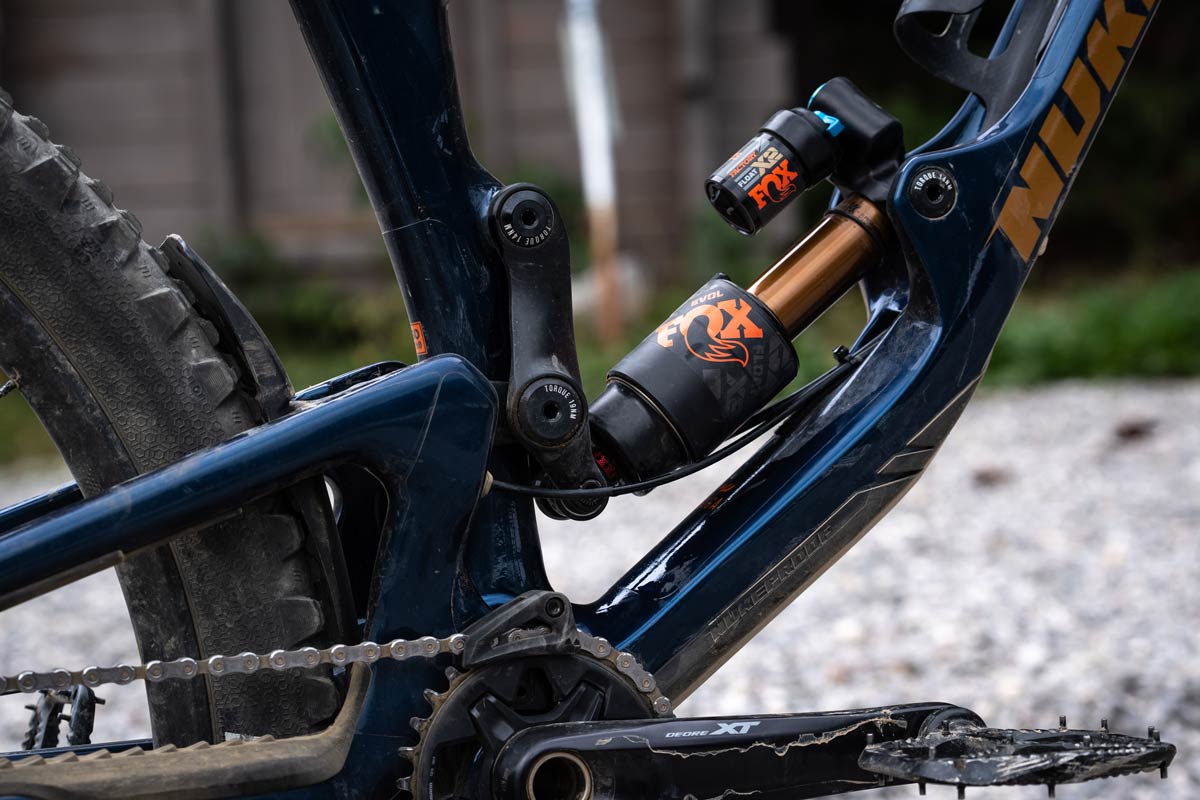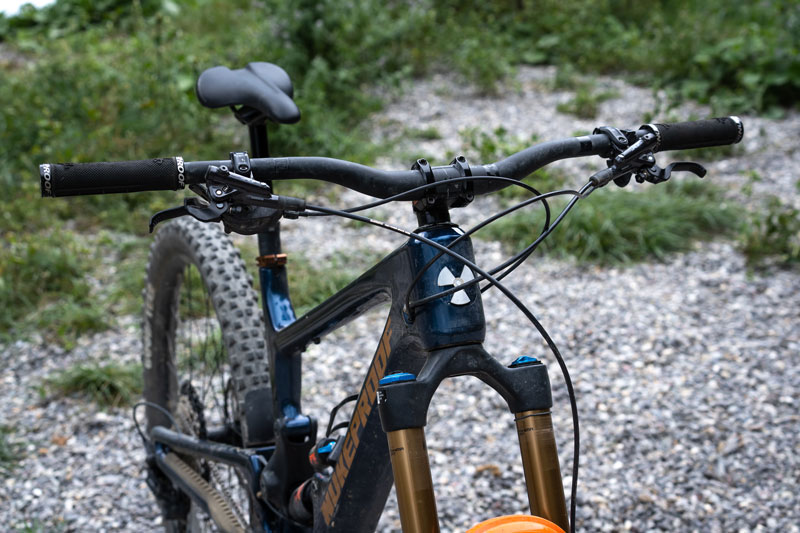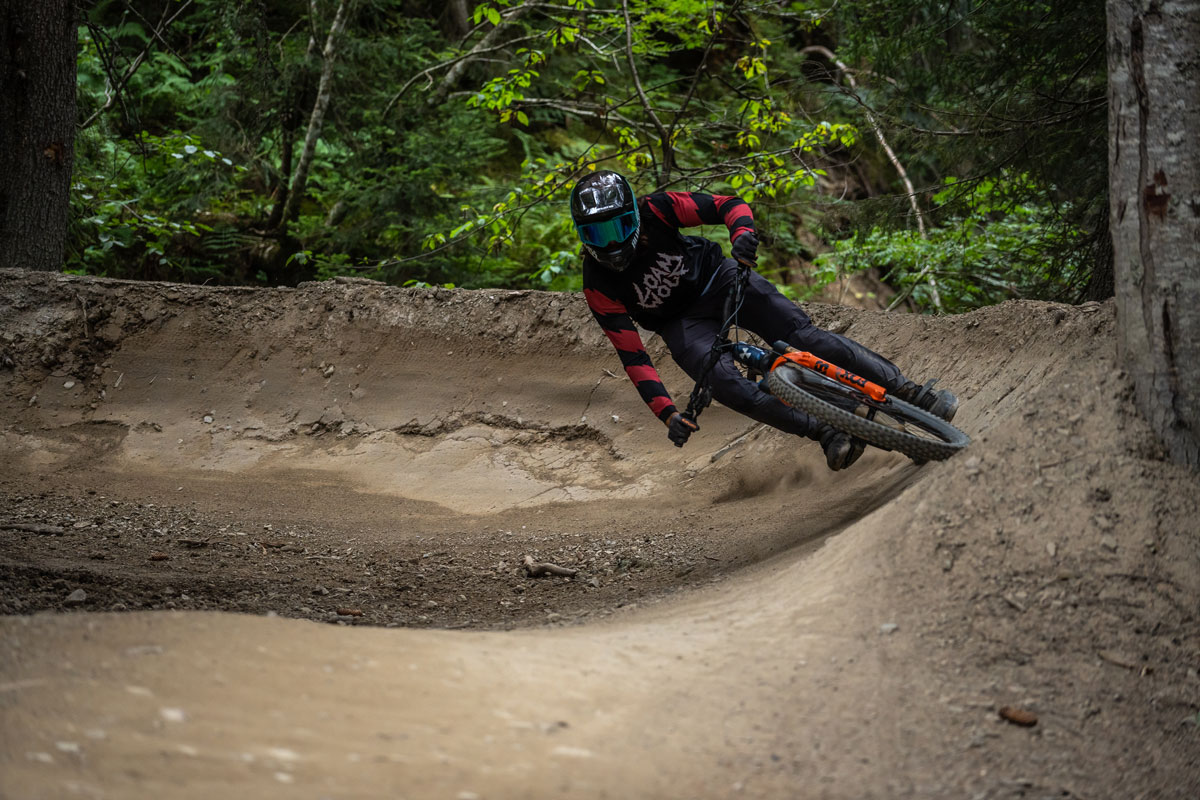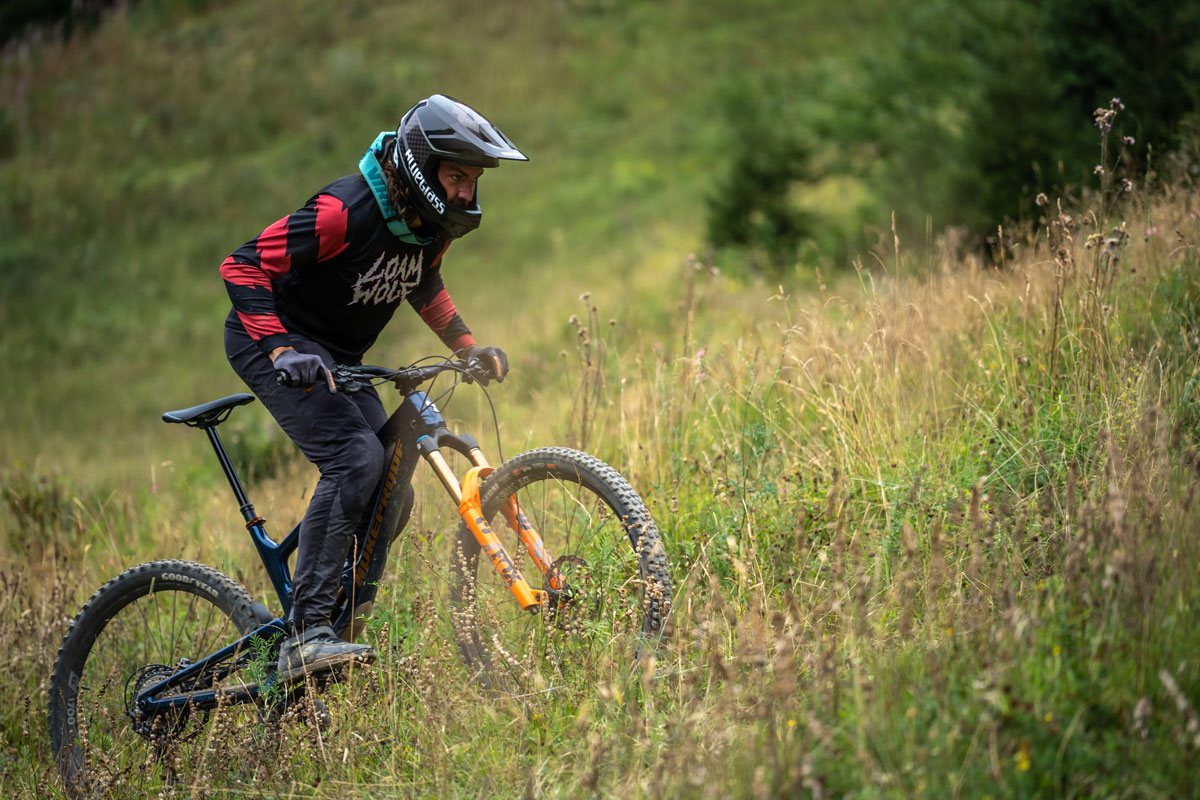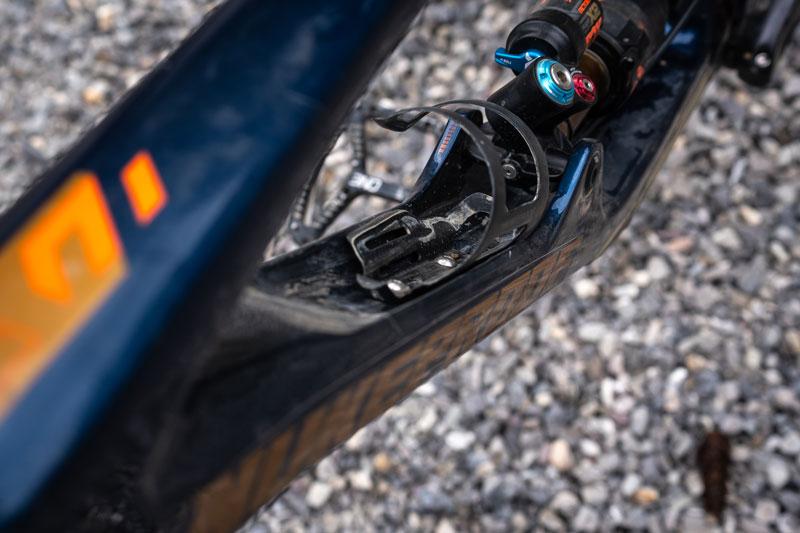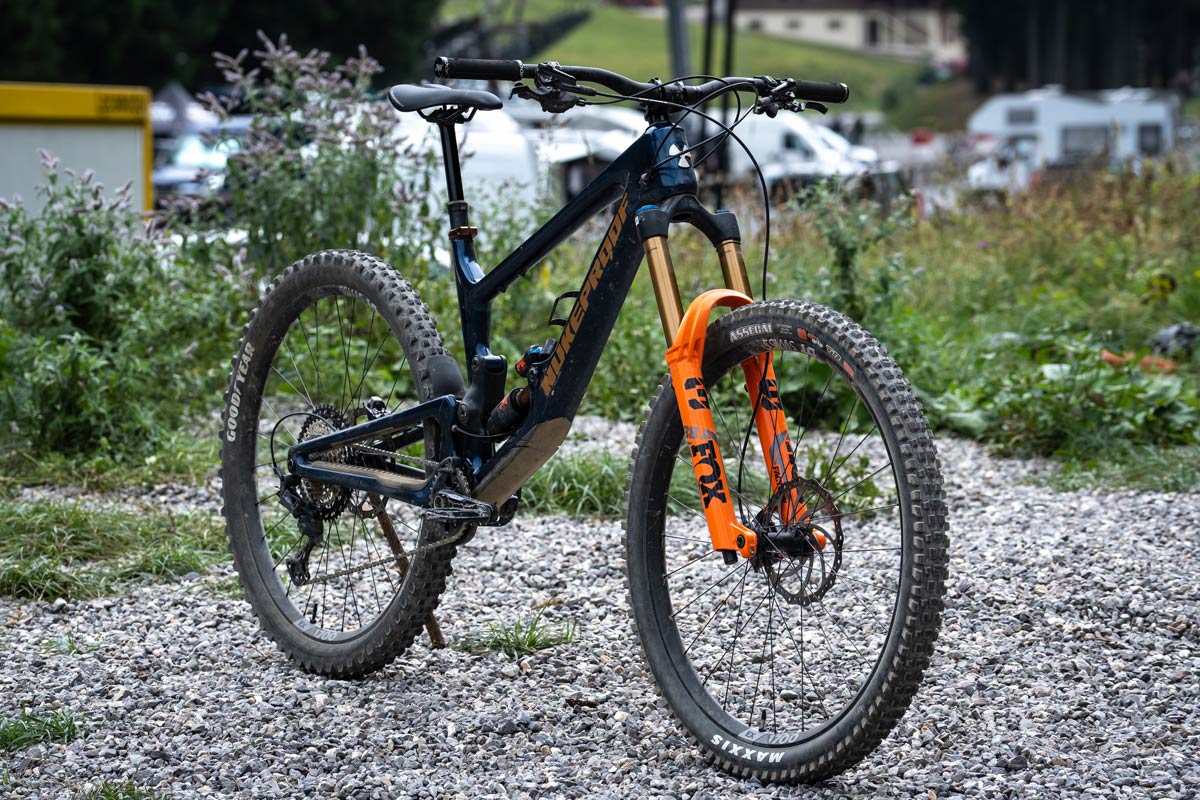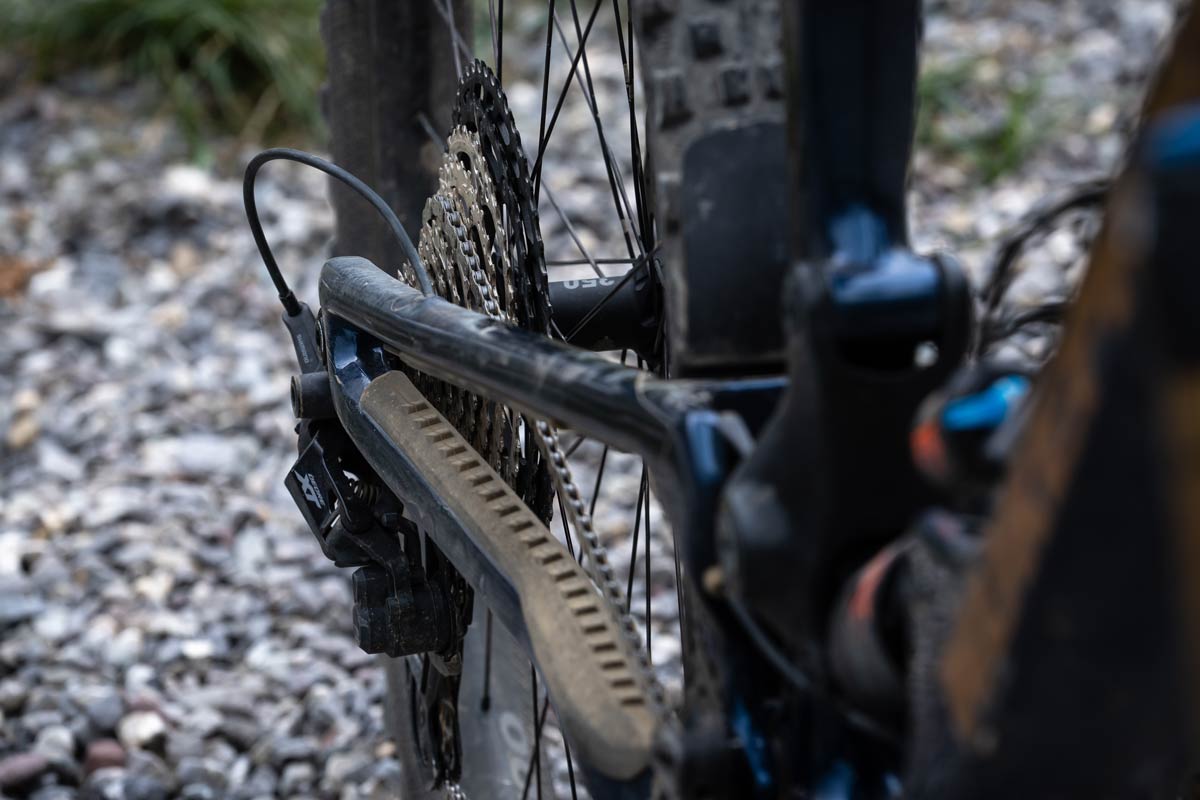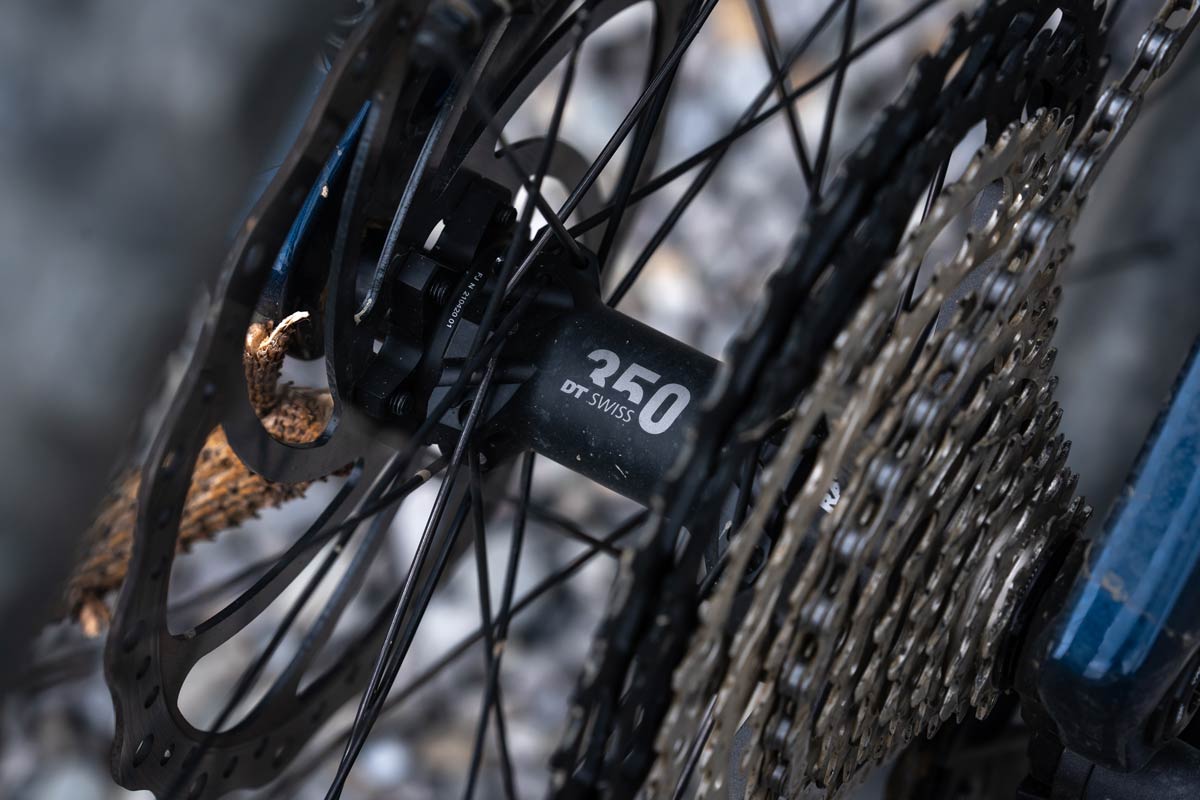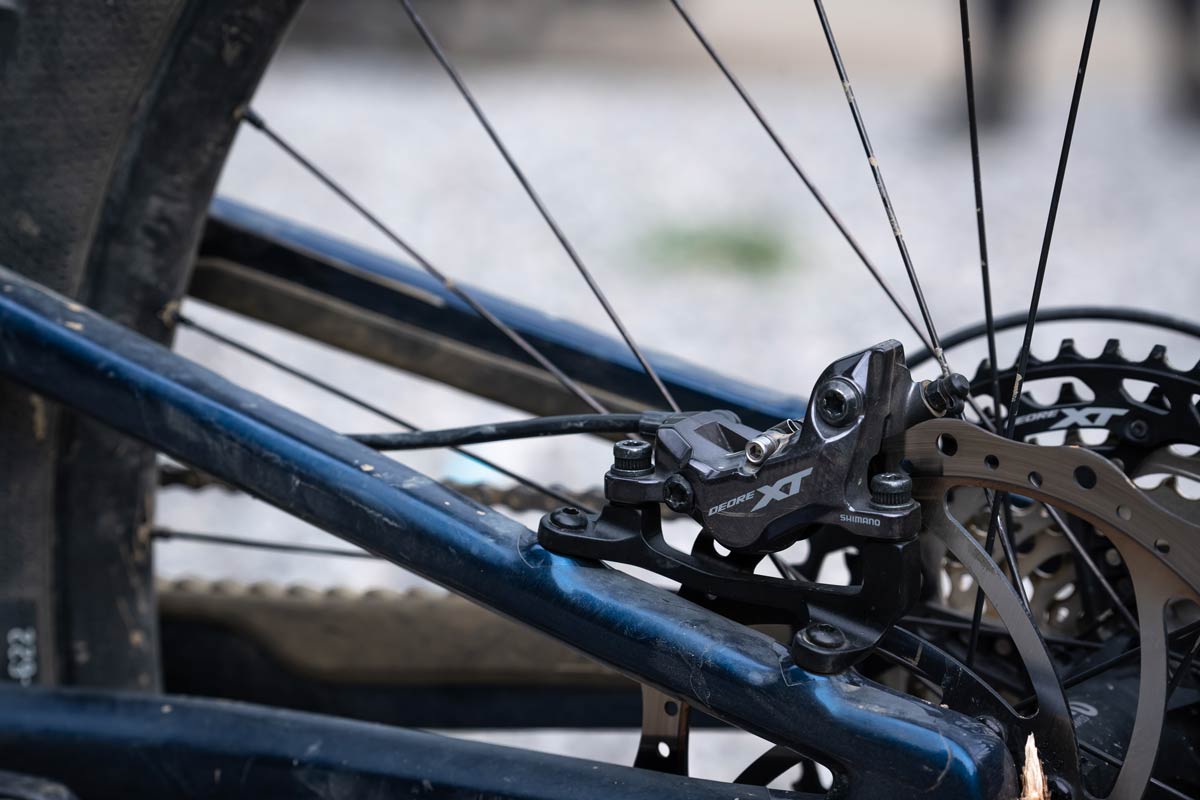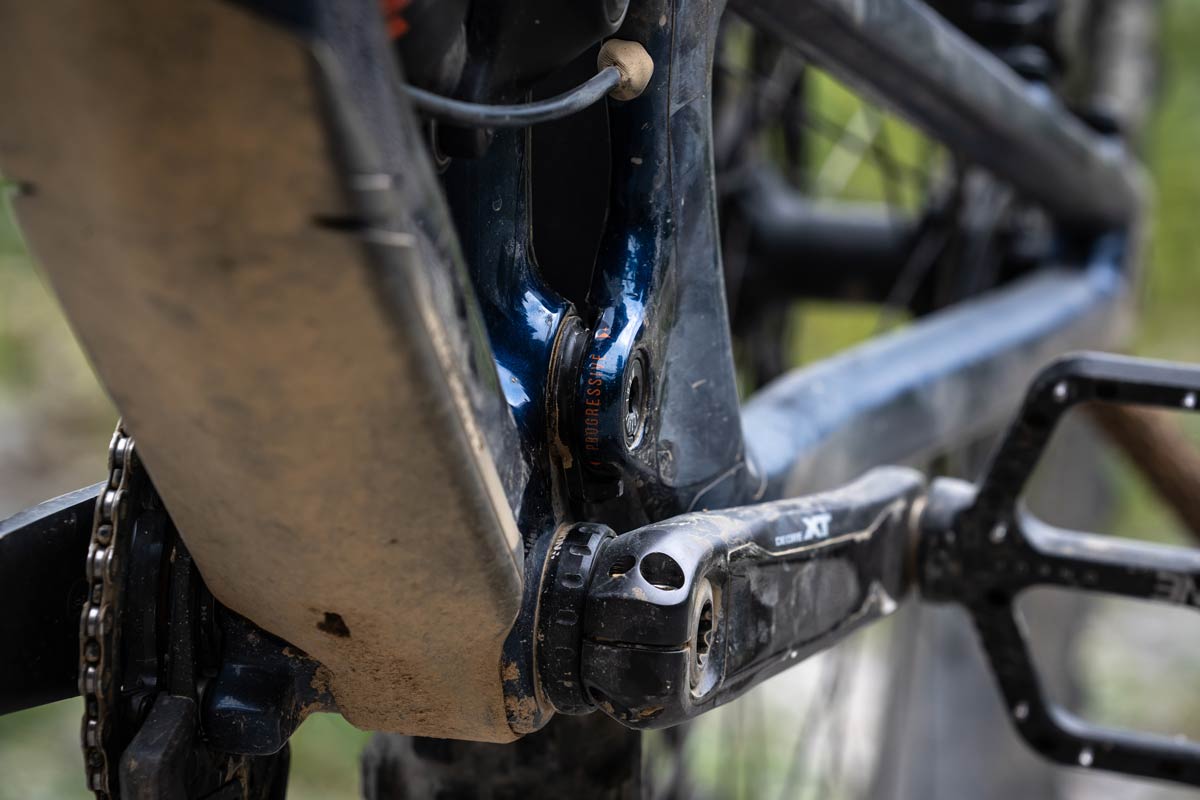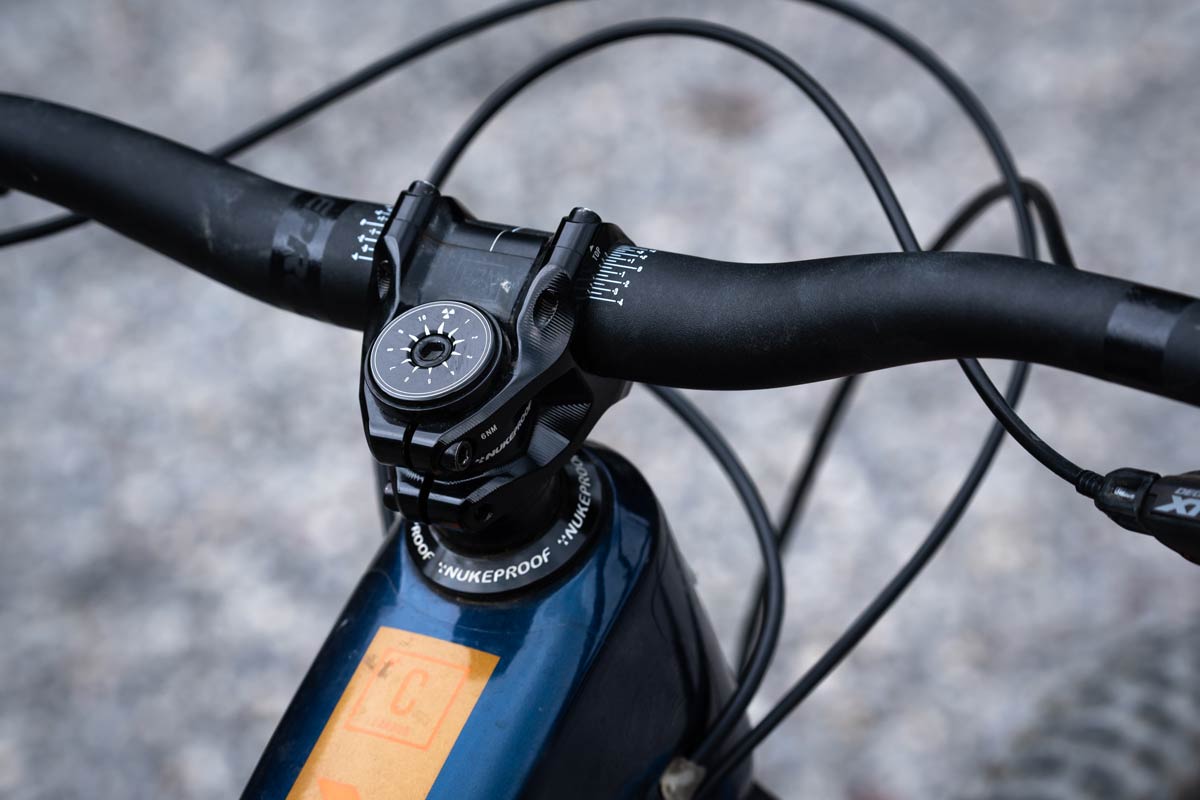
NUKEPROOF GIGA CARBON 290 REVIEW
SUPER CAPABLE, NOT SUPER ENDURO
Review by Robert Johnston
Photos by Ben Gerrish
When Nukeproof were developing their latest downhill bike, the Dissent, they had the idea to adapt it into a “super enduro” machine, taking the new suspension layout with low-slung shock and adding some pedal-friendly geometry tweaks to produce a long travel machine that would be versatile enough to pedal all day. The result was the highly capable Nukeproof Giga, a 170mm or 180mm travel machine designed to offer downhill-like full throttle descending with versatility for trails outside of the bike park. We had the chance to put the Giga Carbon 290 to the test in the Alps last summer, and it’s safe to say that their hooliganistic claims rang true, but it wasn’t all smooth sailing. Read on to find out why.
QUICK HITS
• 29” wheels tested, 27.5” and Mixed wheel options
• 170mm Linkage Driven Single Pivot Suspension
• HTA 63.5
• STA 78 (effective)
• REACH 495 (XL)
Price: Europe | €4,699 – €7,999 // US | $4,899 – $7,899
Website: Nukeproof.com | us.Nukeproof.com
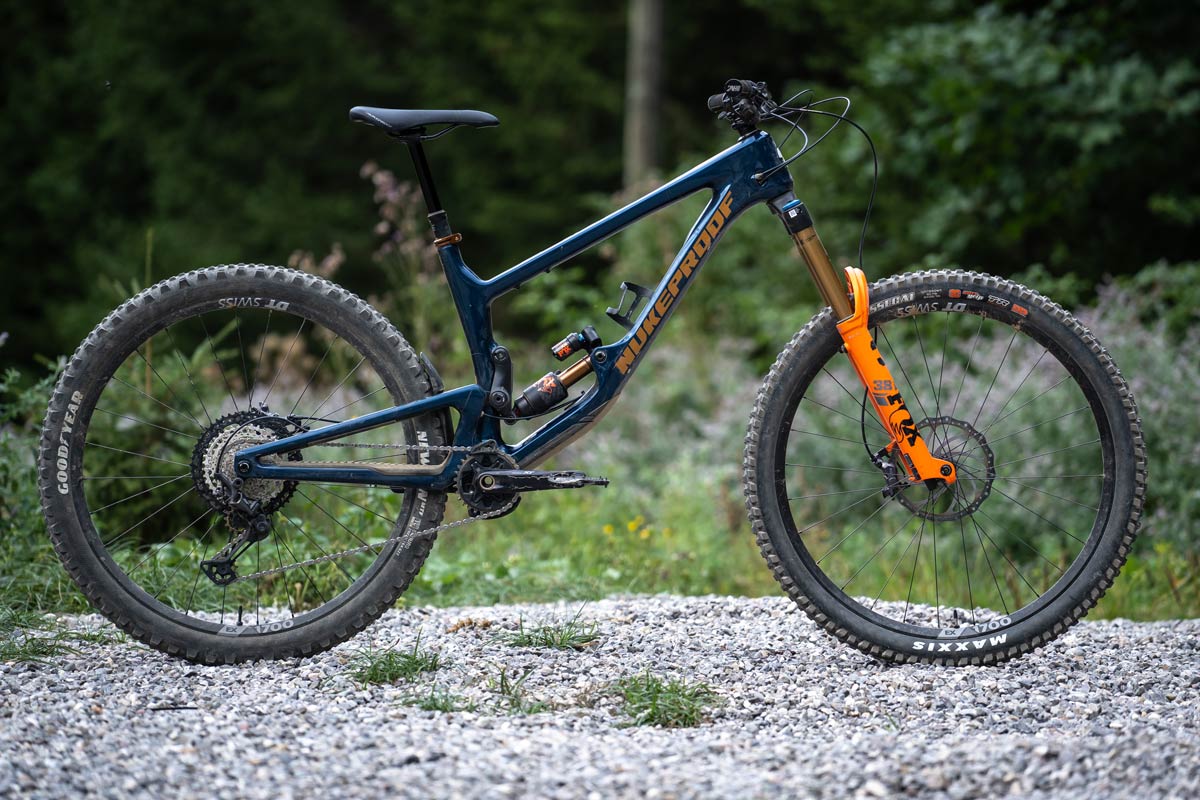
THE LAB
Developed as a pedal-friendly mini downhill, or in modern terms a “super enduro” bike, the Nukeproof Giga reviewed here, is offered in carbon fiber only, which allowed them to tailor its shape to give it the clean and fast looking lines they desired. With its “ultra-strong monocoque front triangle” made with UD (unidirectional) carbon, the Giga Carbon comes in at a respectable weight for a bike with such hard hitting intentions at 35.6lbs/16.16kg all-in (measured). Understanding that riders in this mini downhill/super-enduro/modern freeride camp have their own strong preferences on wheel size, they decided to cater for all by offering distinct dual 27.5” (Giga 275); mixed 29” front and 27.5” rear (Giga 297), or dual 29” (Giga 290, reviewed) options, with tailored frames to give optimal geometry for each. The 275 and 297 models offer 180mm travel on both ends, whereas the 290 steps down to 170mm in the rear to account for the larger rear wheel. Crucially these frames have unique rear ends and as such cannot be adapted from one wheel size to another without modifying the geometry considerably.
The Nukeproof Giga Carbon frame has quite a uniquely shaped downtube, where the top side of the carbon fiber is sculpted to offer a sunk-in bottle cage, giving ample clearance for a 750ml bottle on all sizes and a clean look. There is SRAM’s Universal Derailleur Hanger (UDH) to make finding replacements easier; an accessory mount on the underside of the top tube; a threaded BB; ISCG05 mounts; an integrated rear fender, and large clearance to fit a 2.5” rear tire with some breathing room. The Giga comes equipped with clear protection tape to protect the paint finish as standard, and features contoured rubber protectors on the downtube, chain stay and seat stay to keep damage and noise to a minimum. The internal cable routing makes use of piping to reduce noise, but foregoes any clamping, which we’ll talk about later.
Regardless of the wheel size selected, the Giga makes use of a linkage-driven single pivot suspension setup to control the rear wheel. The shock sits low in the frame, to give a low center of gravity and allow for that large water bottle to fit inside the front triangle. The main pivot is equipped with an eccentric insert, which allows for the progression of the leverage ratio to be tweaked between 25.5% and 29% settings. In the more progressive setting, there’s 85% anti squat at sag in the largest cog, which falls through the cassette down to 43% in the smallest. These figures are very low for a bike with pedaling on the menu, especially in the hardest gears, which should result in a highly active rear end when pedaling hard. The anti rise on the other hand is quite high, sitting just shy of 100% at sag. This should prevent any rear end rise as a result of the rear brake, maintaining the geometry of the bike and aiding confidence in the steeps at the expense of a firmer rear end when braking. It falls constantly to 80% at bottom out, which should aid recovery of the rear end when braking through hard compressions.

Geometry on the Nukeproof Giga varies slightly with each different wheel size option, with the 275 and 297 having a 10mm shorter rear end, 5mm longer reach and 17mm less bottom bracket drop. The rest of the numbers are the same or very similar compared with the 290 Giga reviewed here. The 275 and 290 have a small to XXL size range to fit riders between 5’2” and 6’7”, whereas the 297 is only offered in small through to large. The XL size 290 tested sports a 495mm reach and 640mm stack, which proved to be comfortable for me at 6’2” with a slightly shorter 35mm stem fitted. There’s a 63.5-degree head tube angle across the sizes, as well as a shared 78 degree effective seat tube angle; 445mm long rear end and 25mm bottom bracket drop. The wheelbase totals a lengthy 1290mm for the XL tested (with the large coming in at a still-lengthy 1265mm), which says all there is to say about its intentions – this is a long and stable bike designed to be thrown down the roughest and rowdiest of pedal-accessed descents.
Nukeproof’s Giga 290 and 297 are offered in a choice of four build specs, or as a frame option with choice of different shocks, whereas the 275 is currently only offered as a frame and shock from £2,599/$3,399. The 290 range goes from the £3,699/$5,169 Comp to the £6,299/$7,899 RS spec, with the Factory spec tested sitting at £5,499/$7,339. This Factory spec is equipped with a high end but not quite top-tier build kit. The suspension package consists of a 180mm Fox 38 fork and Float X2 shock combination, in the apt Factory level, complete with 4-way damping adjustments and Kashima coatings. The groupset and brakes are all Shimano XT, with their four-pot stoppers clamping on a pair of 203mm rotors, and 12 speed gearing with 10-51T cassette. The wheels are DT Swiss EX1700 Spline 30, which are wrapped in a Double Down casing Maxxis Assegai/DHR2 tire pairing. Nukeproof supplies a 31.8mm diameter cockpit, with their 25mm rise Horizon V2 bar and Horizon stem in 45mm as standard. There’s a Nukeproof saddle too, as well as their Bash Guide. Rounding out the specs is the Bikeyoke Divine stealth dropper with 185mm of travel (160mm on S/M), actuated by a Brand-X remote lever. All in all, a solid spec befitting of a bike that’s designed to take super enduro abuse.

THE DIRT
I was fortunate to be in the French Alps for the entirety of what turned out to be a short (but still satisfactory) test period on the Nukeproof Giga 290 Factory. With some of the world’s best lift-assisted trails and some truly epic high Alpine pedaling to be sampled, it didn’t take long to deduce where the Giga shines so bright, and where things are dimmer.
With the air-sprung Float X2 shock out back, I opted to begin in the less progressive of the two settings on the main pivot, to ensure I would be able to make full use of the travel. This is where the Giga remained until its penultimate ride, as it proved to offer sufficient bottom out resistance and mid stroke support. The last couple of rides using the more progressive setting didn’t add anything great to the performance for me, but slightly enhanced the drawbacks that we’ll get onto in a bit. Changing between the two settings was relatively easy with just an 8mm allen key and some thumb muscle, which could be interesting for riders looking to tailor the feel of the bike to the trails ahead.
As the Giga is Nukeproof’s super enduro bike, I’ll begin with its primary focus – the way down the hill. From the infamous Champéry world cup downhill track, to the high speed bikepark hits at Châtel, and even the off-piste steeps of Le Pleney, the Giga was subjected to a test satisfactory for any super enduro, mini-dh or even downhill machine. The latter bike category is the mindset it encouraged the most, with early-stroke sensitivity that begged to attack the rough, and enough support and composure late in the stroke to shake off the hard compressions. The stand out notion with the Giga’s performance was how impressively unphased it would be by gnarly terrain, ironing out the meaningless chatter and letting you focus on the larger features on the trail ahead. This is partly to do with the compliance offered by the frame and wheel setup, which was much appreciated. It generated a notable level of traction on the off camber hits, and meant the bike was much more stable when turning in the rough.

The mid-length rear end and long wheelbase gave the Giga a great balanced feel, positioning me in the middle of the wheels and requiring less active movement fore and aft to maintain the traction. The stability, balance and surefootedness it offered meant I was focusing on the important stuff, like ideal braking zones and line choice, meaning I was riding the bike as good as I’ve ridden just about anything – smooth, controlled and fast…for me at least. The stability-inducing length does of course come at the expense of low speed maneuverability, making the Giga a bit of a handful when it gets highly tech, but not unmanageably so.
In the high speed bikepark runs with big jump takeoffs, getting airborne was an absolute delight, with stability in the air that led me to feel comfortable throwing and catching some of the better whips of my life, and seldom any notion of a bottom out. When it came to the more natural terrain or the more technical jump lines though, that sensitive early stroke began to reveal the first weakness of the Giga, requiring a considerable yank on the bars to pop and play in situations where airtime was not a given, and instead preferring to remain with the tires grounded and generating the sweet traction that it produces in abundance. Similarly the ability to generate speed through working the terrain and pumping through the rear end is not so good, with the mid-stroke being a little “dead”. Give it some gravity and some gnar though, and the ability of that mid-stroke to iron out the impacts may just be worth the tradeoff. The Giga doesn’t need to be pushed hard though, happily eating up the terrain below at lower speeds and providing a comfortable machine to ride all day long. Hitting the anchors hard, the Giga firmed up a notable but not excessive amount, with the benefit of a composed, neutral chassis position when braking in steep terrain. It’ll certainly benefit from good technique and braking in well considered spots, but won’t necessarily beat up a serial brake dragger.
Getting back up the hill, there was no mistaking the “super” part of the super enduro designation Nukeproof gives the Giga. Pedaling seated was reasonable thanks to a nicely centered body position and acceptable overall weight, meaning that it didn’t shy away from some bigger days in the saddle, especially when climbing on fire roads and making use of the climb switch on the Float X2 shock. However, I quickly began to feel the drawbacks of the “not-so-mini DH bike” sensation when laying down the power out of the saddle, receiving a decidedly DH-feeling soft and wallowy response. This won’t matter to everyone, and aided in traction pedaling through rougher sections of trail, but it doesn’t inspire the kind of hard pedaling efforts you’d want to make if you’re chasing the clock on a pedal-intensive enduro race stage. Climbing tech ascents, the grip levels may aid in finding the last bit of traction, and the balance and front wheel weighting are good, but in more dynamic situations it feels like a real handful. I think the Giga would really benefit from a remote lockout setup for racing scenarios, but for casual riding I wouldn’t see the need. Overall there’s a bit of energy loss when pedaling hard, but there’ll be some balance with the energy saved on the rough descents thanks to the ability to eat up the chunk below. I’m not sure where the tipping point would be in an enduro race, but clearly there are benefits to be had, judging by the great performances by Innes Graham and Elliot Heap on the EWS circuit last year on their Gigas.
When the riding on the Giga was good, it was really really good. The security and confidence it offers to charge rough terrain is truly class leading. However in what was a relatively short testing period there were a number of issues that soured my overall taste. Some of these issues were easily fixed, and some were potentially freak incidents, but in what ended up being just eight big rides there was a lot to discuss.
First up and easily forgiven with the ongoing state of component shortages were the unbranded, cheap rotors fitted to my test bike, instead of the Shimano alloy-carrier rotors pictured on their site. Out the box these rotors really sucked – warping under heat quickly and heating up the sintered pads to the point of glazing after every few steep laps. On the very first run, the Double Down rear tyre ripped to an extent that had it ready for the trash. This was a great shame, but one of those freak occurrences that you have to take on the chin as a mountain biker.
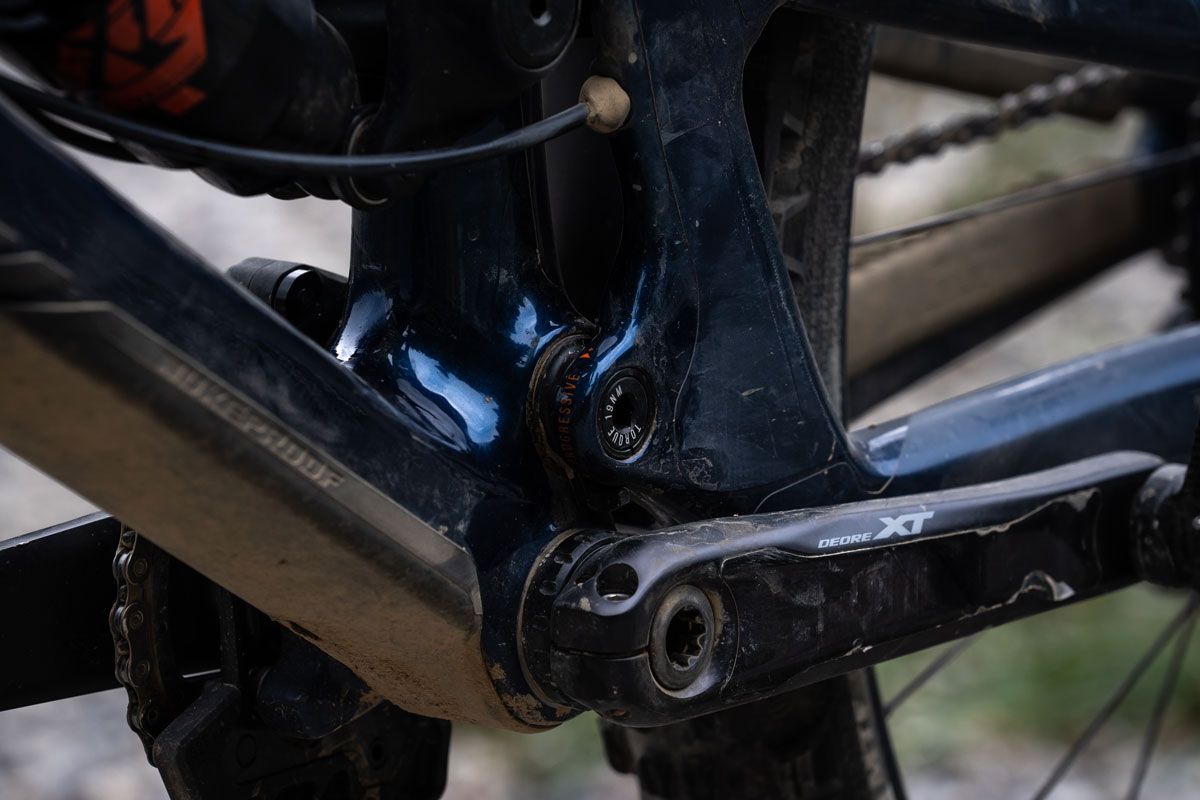
A more frustrating and downright disappointing matter was the extreme rattle of the cables in the frame. The blurb for the bike states that they’re “internally piped”, but that wasn’t the case with my bike. Other bikes may fare differently, but I’ve heard from other riders that their Giga needed some attention to run quietly – if you’re owning the bike for a long time, this will likely not be too much of an issue as once it’s done it’s done. I added a zip tie and some protection below the downtube exit and it helped a bit, but the real issue is the lack of clamping or proper guiding for the cables within the frames. Customers may have to be prepared to create their own solutions to manage the cable rattle as it was excessive and distracting enough to detract from the ride experience. I created some cable stops with moldable glue, which did the trick great…for half a day riding. Some stick-on cable guides next to the ports would likely do the trick.
Just about every bolt on the frame came loose after just 2 bikepark runs – there’s the potential that they were under torqued from the factory, as once tightened to spec they held solid through the remainder of testing, but it’s worrying all the same as loose frame hardware can cause serious frame damage or injury if not caught in time. Be prepared to check and re-check the frame hardware initially to be sure.
As we understand to be the case for many riders out there, the Fox Float X2 shock fitted to the bike decided to release all of its damping oil after just 6 rides. This left me with a violent pogo stick for a large pedal back to home base, and a bike that was unrideable until a replacement was sorted. I can’t hold this against Nukeproof, but it’s not an isolated incident with these shocks and so riders may seek to swap it out with a more reliable unit if they’re likely to be left in an awkward situation. It’s a shame though, as when they work the latest Float X2 shocks are excellent.
Once I had sourced a temporary Float X2 shock to allow testing to resume, I got just two more rides out of the Giga before a loud creak developed, which led me to carry out a full inspection of the frame. Immediately under some dirt that had stuck to oil left over from the Float X2 issue, I spotted the cause of this creak – a rather large crack around the main pivot. During the testing period I was undoubtedly riding hard, but I had gelled with the Giga well, so this hard riding was conducted with next to no sketchy antics involved. Certainly nothing that I would expect to threaten the construction of a mini downhill rig like the Giga. Nukeproof took the matter very seriously, giving the frame a full inspection to determine the cause of an issue in a zone where there is supposedly a huge thickness of material to give the strength and stiffness required to match the Giga’s intentions. Their feedback to the issue read:
“We take any product failure seriously at Nukeproof. We accept that frame breakages will arise with the nature of the riding we target our products towards, but always aim to ensure this is kept to a minimum by testing well above the industry standards. Lab testing is not the real world, and some issues cannot be predicted. Should a fault occur, we have processes in place to get a rider back on the trails as soon as possible.
Every new issue we receive is an opportunity to learn and improve. The frame Rob used during this test was returned to our lab for a full stress analysis and a full strip down to try to ascertain the root cause of the failure. These tests concluded that the root cause was likely because too much of the carbon layup was removed during the finishing process in one key stress area. Issues like this are normally caught during one of the many QC processes, but this one sadly slipped the net. All carbon frames are made by hand so human error can sometimes play a part during the labour-intensive manufacturing process. It is our opinion that this issue may have combined into a perfect storm of factors (riding style, shock failure etc.) resulting in this failure. We have since taken steps to introduce new procedures during manufacture to minimise the likelihood of this happening again. To keep this in perspective and give confidence to Giga owners or prospective owners: since the launch of the Giga the failure rate is well below the industry average, and the steps taken here to improve our process will only help to reduce this further.
Not only did Nukeproof claim that this was the first issue of it’s kind that they’d seen on the Giga, but after some extensive searching across the internet and putting feelers out with mechanics and people “in the know”, I’d say the broken frame was a freak incident that shouldn’t be a cause for concern for prospective customers. The other issues could be solved by some time spent in the workshop, or by replacement of the rear shock, and are disappointing but not unable to be solved. It wouldn’t be enough to put me off purchasing the Giga if it aligned with my riding intentions. It does the mini DH thing really well.
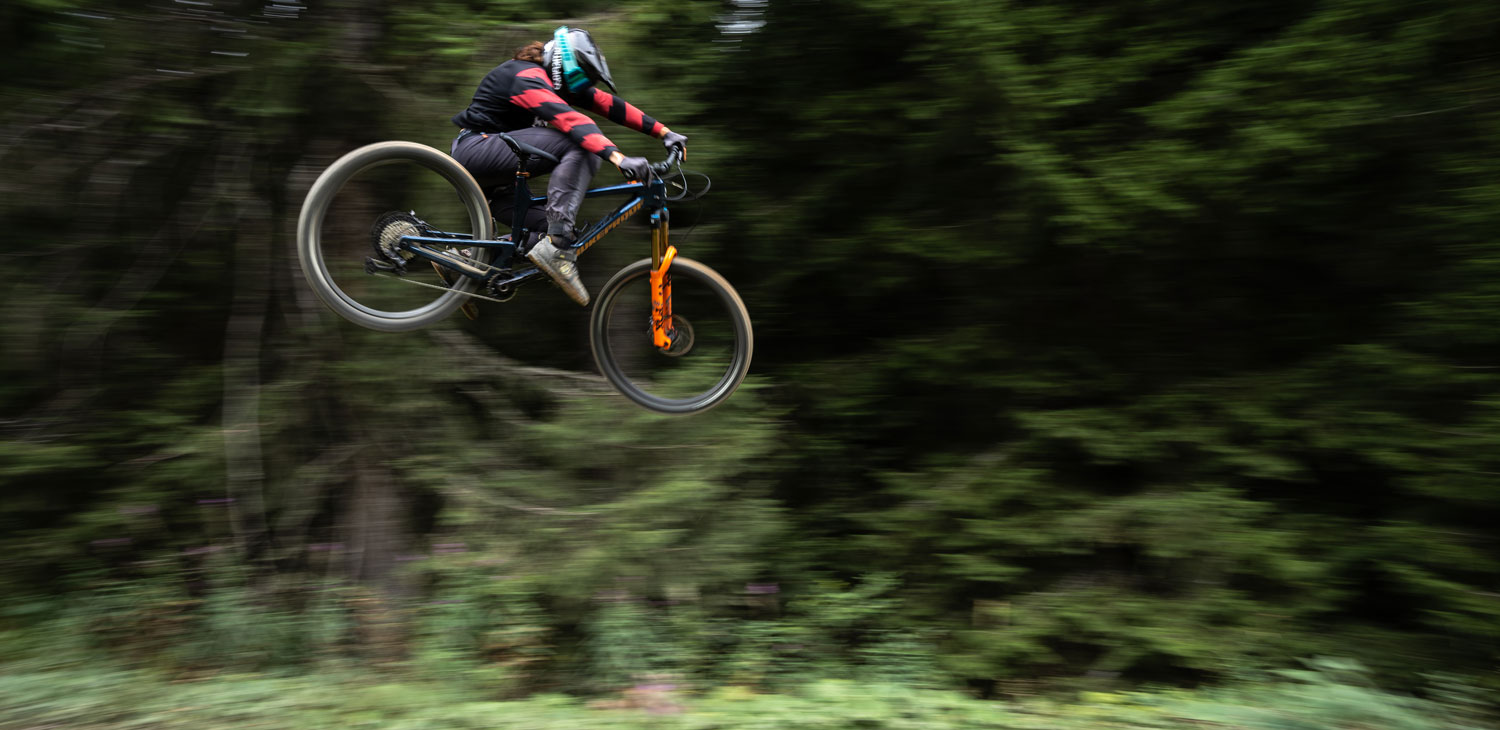
The Wolf’s Last Word
No denying I had some of the best times ever on while reviewing the Nukeproof Giga. I also had some issues: Some minor inconveniences, and a couple of major failures. Take the major failures (which are likely not common issues) out of the equation though, and there’s no denying that as a purpose-crafted climbable downhill bike, it’s quite the machine. With stability and sensitivity that lets you drop the heels and tear up the gnarliest of descents, the Giga is a real animal and I absolutely loved pushing it and myself to the limit! ![]()
Price: $6,899 /£5,499 /€6,999
Weight: 16.16kg (35.6lbs)
Website: Nukeproof.com
SPECIFICATIONS
CHASSIS
Frame: Monocoque UD Carbon; 170mm
Fork: Fox 38 Float Factory 29 | 180mm |Grip 2
Shock: Fox Float X2 Factory | EVOL | 2-pos | 205x60mm
COCKPIT
Brakes: Shimano XT M8120, 203mm rotors
Handlebar: Nukeproof Horizon V2 | 31.8mm clamp | 800mm width | 25mm Rise
Stem: Nukeproof Horizon | 31.8mm clamp | 45mm Length
Seatpost: Bikeyoke Divine Stealth | M:160mm drop | L-XXL:185mm drop
Saddle: Nukeproof
WHEELS
Wheelset: DT Swiss EX1700 Spline 30
Front tire: Maxxis Assegai | MaxxGrip | DD | 29″ x 2.5 WT
Rear tire: Maxxis Minion DHR II | MaxxTerra | DD | 29” x 2.4 WT
DRIVETRAIN
Cassette: Shimano XT M8100 | 12spd | 10-51T
Cranks: Shimano XT M8100 | 32T | 170mm
Shifter: Shimano XT M8100 | 12s
Derailleur: Shimano XT M8100 | SGS | 12s
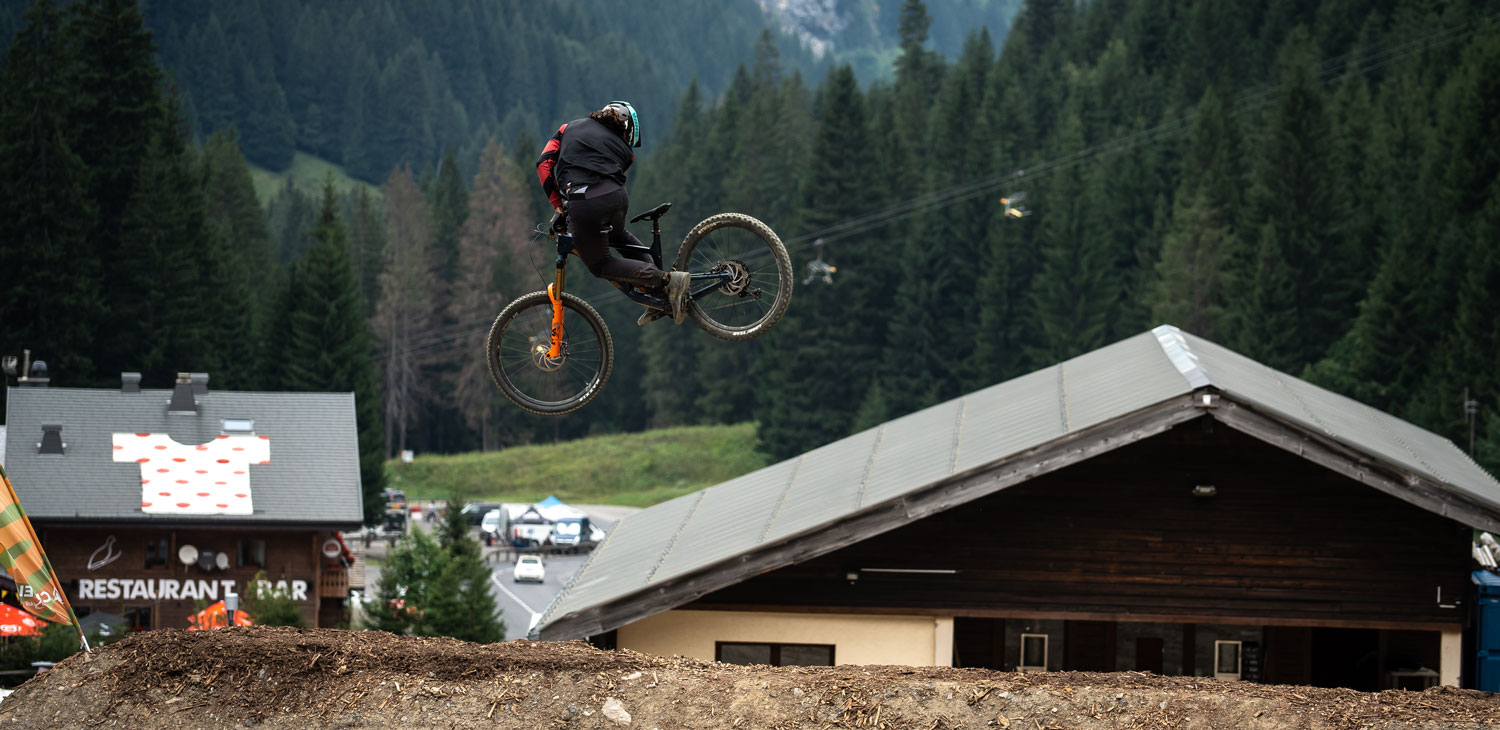
We Dig
Mini DH feel
Great in the air
Suspension feel in varied terrain
Balanced handling
Dialed spec
We Don’t
Cable Rattle
Low speed agility
Frame failure
LEAVE A COMMENT | WIN FREE STUFF
Want to win some free schwag? Leave a comment and vote up the most thoughtful comments and each month we’ll pick a winner. The person with the smartest and most helpful replies will earn some sweet new gear. Join the Pack and get the latest news and read the latest reviews on the top mountain and electric mountain bikes.

